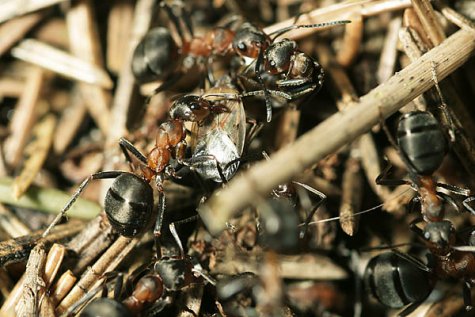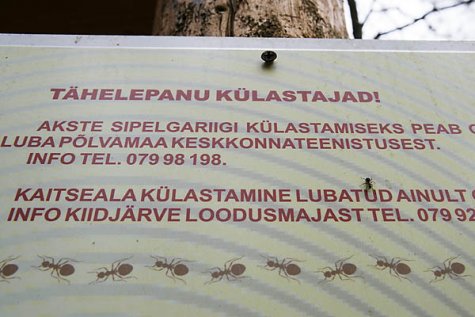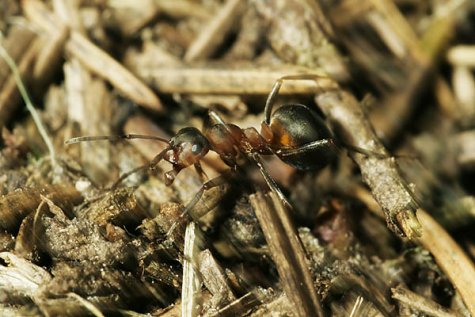Ant world
Text: Urmas Tartes
Photos: Urmas Tartes and Arne Ader
Translation: Liis

Ants make up one-tenth of the mass of living nature. Most of them live inside nest stacks. On the surface of the nest we only find a fraction of the inhabitants of the stack.
All textbooks, handbooks, encyclopaedias, the Internet, lectures and a thousand other sources state: insects are winged and six-legged animals. What use is this knowledge to us when we come across an anthill?
Thousands of tiny beings scurry around on the ground. They all have six legs but we can’t manage to find a single wing. Unless it is an insect prey with crumpled wings being dragged towards the nest by industrious workers.
These tiny bugs that do not fit into our knowledge scheme we could just leave alone. Why should they interfere with our clean-cut understanding of the world! Unfortunately the ants won’t allow themselves to be neglected. Suppose that someone would manage to count how many ants live in the world altogether? It is estimated that if all living matter in the Amazonas rain forests were to be weighed: plants, animals, fungi, algae, and among them certainly ants too, the ants would make up a third of the total. If a similar weighing were to be made for the whole planet it is estimated that the share of the ants would be one tenth.
But if we try to count the individual ants, then we have a problem, because the ants are truly tiny. An average ant weighs about 5 milligrams and for one human there are thousands, if not tens of thousands, of ant individuals. If such a number of insects were to be distributed evenly on the ground then obviously there would be no place on the globe where to set a foot without crushing some of these fascinating insects. Fortunately this does not happen because the ants surprise us once more: ants are social insects who live together in nice anthill homes, as humans do in cities.
Social life means that in the ant hill a community work division system reigns. On the basis of the work division scheme there are many more ants with tasks inside the nest than those who work outside it. Thus it seems at a first glance that there are fewer ants than the numbers tell us. The reason is simple: most of the ants are always hidden from our eyes. And even those who come out from the nest like to climb out of sight into the trees.

Ant walking on sign. Akste
Although the system of division of labour of ants is sometimes described as similar to the caste system in India the organisation of life in an anthill is not as rigid. Every worker ant will start work in the interior of the nest, but in the last years of its life it starts working outside the nest. Today an anthill is not regarded as an analogue to human society but as a super-organism where different individuals perform specific tasks similar to different organs at different stages of life.
Every nest for instance has ants that collect food outside and process it, analogously to a digestive system, to be acceptable to the ants living in the interior of the nest, and ants that deal with removal of waste from the nest as excretion organs, and there are guard ants who act as the immune system of the nest and of course there is a sex organ – the ant queens.

Wood ant (Formica sp)
There are only 250 000 cells in the brain of an ant. Compared to the size of the human brain this is a negligibly small „computer centre“ at first sight. But considering that in each nest tens and hundreds of thousands of ants live together then already the collective brain of an average ant nest super-organism exceeds the volume of a human brain. It is like the Internet where each individual computer may not be powerful but taken together the system can change the whole world.
And ants actually have wings. To discover this you need to go to an anthill at a time when these intriguing little animals have their mating flights.
Translator's note: The sign in the second photo above says that for visiting the Akste area ant realm special permit is required from the Põlvamaa environmental authority.








